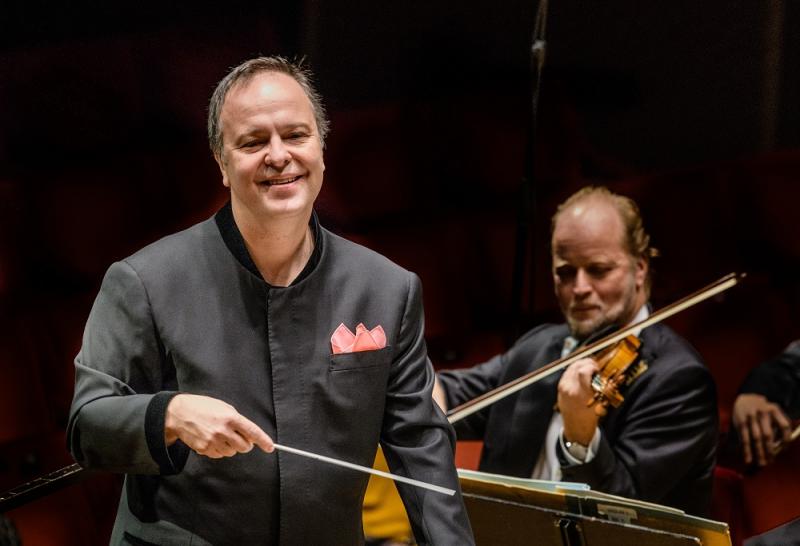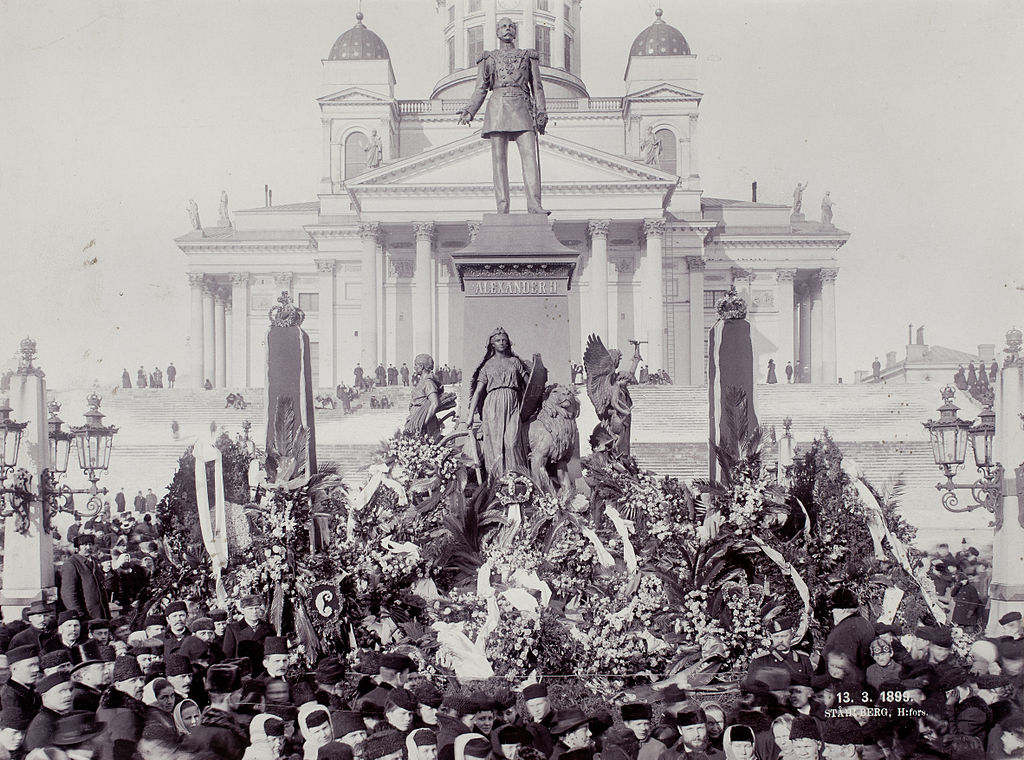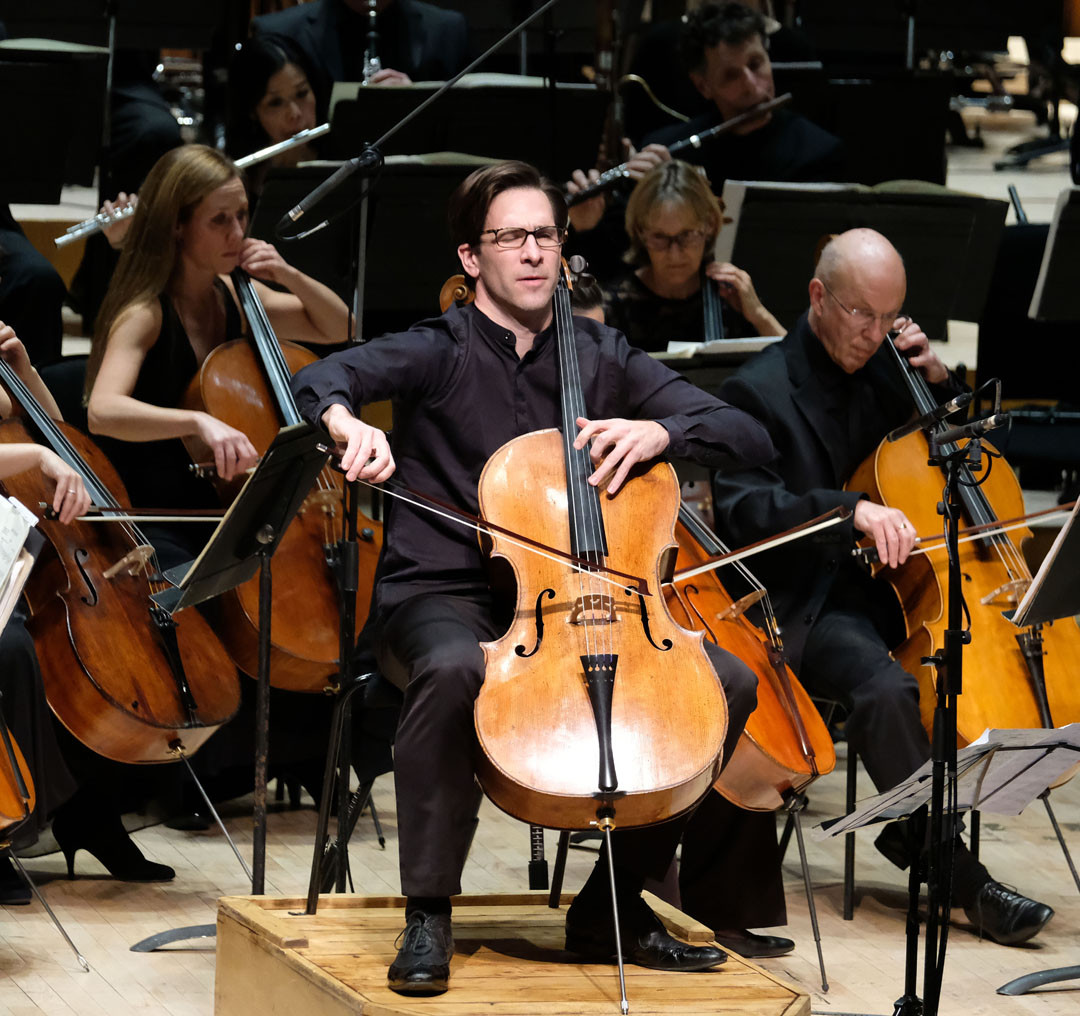Johnston, BBCSO, Oramo, Barbican review - sheer adrenalin in early Sibelius | reviews, news & interviews
Johnston, BBCSO, Oramo, Barbican review - sheer adrenalin in early Sibelius
Johnston, BBCSO, Oramo, Barbican review - sheer adrenalin in early Sibelius
Perfect salute to the Finnish independence centenary includes a vital UK premiere

As the Parliament of the Autonomous Grand Duchy of Finland within the Russian Empire declared independence on 6 December 1917, Sibelius had his head down working on the third version of his Fifth Symphony, the one so hugely popular today.
The background is fascinating, and clearly told in Stephen Johnson's programme note: in short, the Finnish-language press had been closed down in the drive to Russification. The sequence of mythical and historical tableaux for which Sibelius provided such striking music was staged to fund the pensions of those newspaper workers who had been laid off; little did the Russian authorities know how sign and symbol would serve as patriotic flares. Three of the seven numbers Sibelius reworked as the first set of Scènes historiques, rescored but in both versions teeming with invention; Oramo encouraged the ever more refulgent BBCSO strings to show off the depth of their passionate sweep in the European dance-culture of Duke John of Turku's renaissance court, while the brass fanfares bursting out of the proud wind in the Prelude and across the bassoons' lugubriousness for "The Finns in the Thirty Years War" carried an electric charge, like so much in the evening (pictured below: Helsinki citizens in March 1899 protest against the new drive to Russification by laying flowers beneath the statue of 'good' Tsar Alexander II). . More climactic still, the last of the six scenes is what we know as Finlandia, snarling at the start out of eight mesmerising chords – four for wind, four in harmonically astonishing progression for strings, pianissimo, strictly belonging to the end of "The Great Hostility", the pageant's most daring challenge to Russian autocracy in recalling the 1710 occupation of Viipuri province. Oramo, always a master at connecting movements, gave the continuity a special significance.
More climactic still, the last of the six scenes is what we know as Finlandia, snarling at the start out of eight mesmerising chords – four for wind, four in harmonically astonishing progression for strings, pianissimo, strictly belonging to the end of "The Great Hostility", the pageant's most daring challenge to Russian autocracy in recalling the 1710 occupation of Viipuri province. Oramo, always a master at connecting movements, gave the continuity a special significance.
If only that quiet preface could be kept in future performances of Sibelius's best-known work. It was all familiar sailing, with the beautiful song at its heart moved unsentimentally along, until just before the end, where the big tune blares out in full against Brucknerian welters: were it always done as hair-raisingly as this, I'd plump for the original every time. Curiously, though, there seems to be another, less effective ending, which you can catch in Okko Kamu's Lahti performance of the Press Music on YouTube.
Not even passing familiarity occurred in the two short pieces from 1914-15 after the interval, though you can hear Sibelius's characteristic voice at the heart of Cantique, the first of his Two Serious Melodies, and immediately, in the oscillations of lower strings, in Devotion. Cellist Guy Johnston's full tone easily projected over the thickish scoring; he and Oramo kept Cantique, which could stick in the over-sentimental mire given the wrong treatment, judiciously on the move (Johnston at last night's concert pictured below by Ellis O'Brien).  Then it was back to the reckless early SIbelius, teeming with inspiration, in the First Symphony. Having offered us ideal poise in the two leanest symphonies, the Fourth and Sixth, in the previous instalment of the cycle, Oramo went for broke in the hurtling challenges of Sibelius's belated musical adolescence. It was all beautifully modulated beneath the surface, though; while second violins shimmered their souls out to welcome the main idea of the first movement, the ardent melodising had emotional space at just the right points; no conductor manages luftpausen, discreet stops for breath, finer than Oramo, and none is better at keeping the tension over the longer silences, the abyss, between the sounds. Hugely impactful contributions, too, from BBCSO soloists, led by Daniel Pailthorpe and Tomoko Mukai in an ear-tingling flute duet and subtle harp work from Louise Martin (when have you ever heard the instrument have the last, reverberating word at the end of the first movement before?)
Then it was back to the reckless early SIbelius, teeming with inspiration, in the First Symphony. Having offered us ideal poise in the two leanest symphonies, the Fourth and Sixth, in the previous instalment of the cycle, Oramo went for broke in the hurtling challenges of Sibelius's belated musical adolescence. It was all beautifully modulated beneath the surface, though; while second violins shimmered their souls out to welcome the main idea of the first movement, the ardent melodising had emotional space at just the right points; no conductor manages luftpausen, discreet stops for breath, finer than Oramo, and none is better at keeping the tension over the longer silences, the abyss, between the sounds. Hugely impactful contributions, too, from BBCSO soloists, led by Daniel Pailthorpe and Tomoko Mukai in an ear-tingling flute duet and subtle harp work from Louise Martin (when have you ever heard the instrument have the last, reverberating word at the end of the first movement before?)
It might be overkill, but how welcome a concert from this team twinning Sibelius's First with Mahler's might be. The interpretation reminded one how the playing can never be too roughly vigorous in Sibelius's scherzo, as in Mahler's, and both finales begin with what Mahler called "the cry of a deeply wounded heart". If this endgame doesn't go as deep as the composer clearly wanted it to – the best a performance can do is to hold the tension as it falls apart, and the central turbulence here was stupendous – I never had tears in my eyes during the big tune before.
I've heard from the BBC players that Oramo is the only principal conductor they've ever had for whom adoration is unanimous, and when you hear heart and soul so magisterially focused as it has been throughout this series so far – there's one more to go, in January – you have to believe it. One final burst of applause for Oramo's succinct and perfect spoken introduction: he managed to reference the brevity of 100 years, from his grandparents as Russian subjects to himself as a second-generation citizen of independent Finland, great Finnish men and strong Finnish women in the arts (three examples of each), and the hope that his country would embrace "wider views and bolder visions" given the troubles we face today. Quite a Mensch.
rating
Share this article
The future of Arts Journalism
You can stop theartsdesk.com closing!
We urgently need financing to survive. Our fundraising drive has thus far raised £33,000 but we need to reach £100,000 or we will be forced to close. Please contribute here: https://gofund.me/c3f6033d
And if you can forward this information to anyone who might assist, we’d be grateful.

Subscribe to theartsdesk.com
Thank you for continuing to read our work on theartsdesk.com. For unlimited access to every article in its entirety, including our archive of more than 15,000 pieces, we're asking for £5 per month or £40 per year. We feel it's a very good deal, and hope you do too.
To take a subscription now simply click here.
And if you're looking for that extra gift for a friend or family member, why not treat them to a theartsdesk.com gift subscription?
more Classical music
 Goldberg Variations, Ólafsson, Wigmore Hall review - Bach in the shadow of Beethoven
Late changes, and new dramas, from the Icelandic superstar
Goldberg Variations, Ólafsson, Wigmore Hall review - Bach in the shadow of Beethoven
Late changes, and new dramas, from the Icelandic superstar
 Mahler's Ninth, BBC Philharmonic, Gamzou, Bridgewater Hall, Manchester review - vision and intensity
A composer-conductor interprets the last completed symphony in breathtaking style
Mahler's Ninth, BBC Philharmonic, Gamzou, Bridgewater Hall, Manchester review - vision and intensity
A composer-conductor interprets the last completed symphony in breathtaking style
 St Matthew Passion, Dunedin Consort, Butt, Queen’s Hall, Edinburgh review - life, meaning and depth
Annual Scottish airing is crowned by grounded conducting and Ashley Riches’ Christ
St Matthew Passion, Dunedin Consort, Butt, Queen’s Hall, Edinburgh review - life, meaning and depth
Annual Scottish airing is crowned by grounded conducting and Ashley Riches’ Christ
 St Matthew Passion, Irish Baroque Orchestra, Whelan, St Patrick’s Cathedral, Dublin review - the heights rescaled
Helen Charlston and Nicholas Mulroy join the lineup in the best Bach anywhere
St Matthew Passion, Irish Baroque Orchestra, Whelan, St Patrick’s Cathedral, Dublin review - the heights rescaled
Helen Charlston and Nicholas Mulroy join the lineup in the best Bach anywhere
 Kraggerud, Irish Chamber Orchestra, RIAM Dublin review - stomping, dancing, magical Vivaldi plus
Norwegian violinist and composer gives a perfect programme with vivacious accomplices
Kraggerud, Irish Chamber Orchestra, RIAM Dublin review - stomping, dancing, magical Vivaldi plus
Norwegian violinist and composer gives a perfect programme with vivacious accomplices
 Small, Hallé, Wong, Bridgewater Hall, Manchester review - return to Shostakovich’s ambiguous triumphalism
Illumination from a conductor with his own signature
Small, Hallé, Wong, Bridgewater Hall, Manchester review - return to Shostakovich’s ambiguous triumphalism
Illumination from a conductor with his own signature
 LSO, Noseda, Barbican review - Half Six shake-up
Principal guest conductor is adrenalin-charged in presentation of a Prokofiev monster
LSO, Noseda, Barbican review - Half Six shake-up
Principal guest conductor is adrenalin-charged in presentation of a Prokofiev monster
 Frang, LPO, Jurowski, RFH review - every beauty revealed
Schumann rarity equals Beethoven and Schubert in perfectly executed programme
Frang, LPO, Jurowski, RFH review - every beauty revealed
Schumann rarity equals Beethoven and Schubert in perfectly executed programme
 Levit, Sternath, Wigmore Hall review - pushing the boundaries in Prokofiev and Shostakovich
Master pianist shines the spotlight on star protégé in another unique programme
Levit, Sternath, Wigmore Hall review - pushing the boundaries in Prokofiev and Shostakovich
Master pianist shines the spotlight on star protégé in another unique programme
 Classical CDs: Big bands, beasts and birdcalls
Italian songs, Viennese chamber music and an enterprising guitar quartet
Classical CDs: Big bands, beasts and birdcalls
Italian songs, Viennese chamber music and an enterprising guitar quartet
 Connolly, BBC Philharmonic, Paterson, Bridgewater Hall, Manchester review - a journey through French splendours
Magic in lesser-known works of Duruflé and Chausson
Connolly, BBC Philharmonic, Paterson, Bridgewater Hall, Manchester review - a journey through French splendours
Magic in lesser-known works of Duruflé and Chausson
 Biss, National Symphony Orchestra, Kuokman, NCH Dublin review - full house goes wild for vivid epics
Passionate and precise playing of Brahms and Berlioz under a dancing master
Biss, National Symphony Orchestra, Kuokman, NCH Dublin review - full house goes wild for vivid epics
Passionate and precise playing of Brahms and Berlioz under a dancing master

Add comment